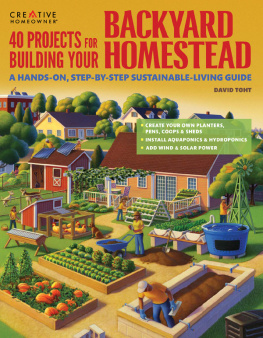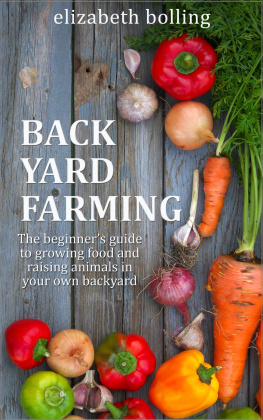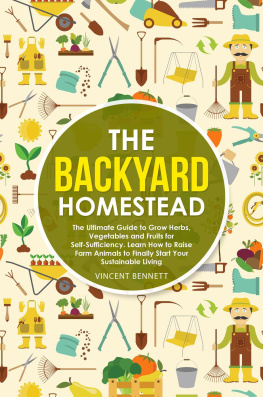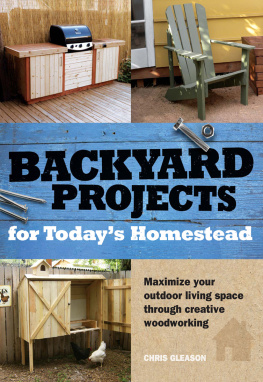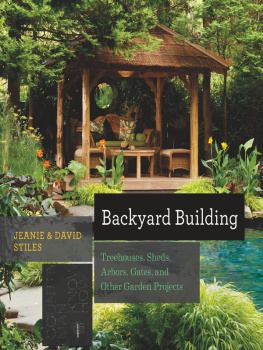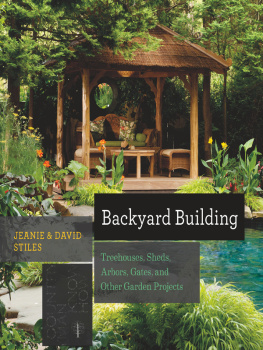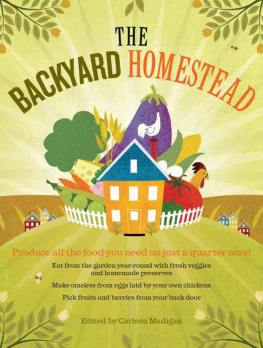Contents
Guide



DAVID TOHT has more than 60 how-to books to his credit. He considers harvesting a sun-warmed tomato from his own garden one of lifes sweetest pleasures. He and his wife, Rebecca, live in Olympia, Washington, with their dog, cat, and three chickens.

Acknowledgments
Special thanks to those who generously shared their time and expertise, including Luis Apolinar, David and Heather Armitage, Dan Aulwurm, Chuck Bauer, Marc Bernard, Sylvia Bernstein, Dr. Sally Brown, Kurt Hollis, Daniel Hull, Rebecca Brody Kamerman, Adam Matthews, Roy Stark McGarrah, Sean Millhorn, Ray Rasmussen, John Redd, Terry and Jennifer Shaw, Ernie Schmidt, Adam Toht, and Robin Forsythe.
Safety First
Though all concepts and methods in this book have been reviewed for safety, it is not possible to overstate the importance of using the safest working methods possible. What follows are remindersdos and donts for yard work and landscaping. They are not substitutes for your own common sense.
Always use caution, care, and good judgment when following the procedures described in this book.
Always determine locations of underground utility lines before you dig, and then avoid them by a safe distance. Buried lines may be for gas, electricity, communications, or water. Start research by contacting your local building officials. Also contact local utility companies; they will often send a representative free of charge to help you map their lines. In addition, there are private utility locator firms that may be listed in your Yellow Pages or online. Note: previous owners may have installed underground drainage, sprinkler, and lighting lines without mapping them.
Always read and heed the manufacturers instructions for using a tool, especially the warnings.
Always ensure that the electrical setup is safe; be sure that no circuit is overloaded and that all power tools and electrical outlets are properly grounded and protected by a ground-fault circuit interrupter (GFCI). Do not use power tools in wet locations.
Always wear eye protection when using chemicals, sawing wood, pruning trees and shrubs, using power tools, and striking metal onto metal or concrete.
Always read labels on chemicals, solvents, and other products; provide ventilation; heed warnings.
Always wear heavy rubber gloves rated for chemicals, not mere household rubber gloves, when handling toxins.
Always wear appropriate gloves in situations in which your hands could be injured by rough surfaces, sharp edges, thorns, or poisonous plants.
Always wear a disposable face mask or a special filtering respirator when creating sawdust or working with toxic gardening substances.
Always keep your hands and other body parts away from the business ends of blades, cutters, and bits.
Always obtain approval from local building officials before undertaking construction of permanent structures.
Never work with power tools when you are tired or under the influence of alcohol or drugs.
Never carry sharp or pointed tools, such as knives or saws, in your pockets. If you carry such tools, use special-purpose tool scabbards.
Contents


Introduction
When I was young, my grandparents owned a 240-acre diversified farm in west-central Illinois. For us kids, too young to pitch in with the chores, it was a wonderful playground. If we werent hanging on the fence staring down steers (with one prodigy always coming forward to have his forehead scratched), we were gingerly reaching under hens for eggs or slapping the dusty backs of piglets. The haymow, redolent of alfalfa, was a wonderful jungle gym for climbing, building forts, or swinging Tarzan-style on the dusty old ropes. Our sandbox was a pile of sawdusthen-house litterhauled in from a local whiskey-barrel factory. On a hot day, we could cool off in a bin of shelled corn.

We also got to hang around as Grandpa did the necessary building and repair jobs between regular chores. Fence repair was a constant. For that, he carried the necessary tools, including an early multi-tool, a hammer-like object that was also a pair of pliers and a pry bar all in one, in a metal box attached to the rear mudguard of his tractor. The repairs had to be quick and effective to keep the livestock penned. Extending the concrete pad for the hog shed involved the backbreaking labor of filling a borrowed concrete mixer with sand, gravel, and Portland cement. Poured incrementally over many days, the pad was neither exactly square nor perfectly level, but it served. There just wasnt time for architectural perfection; there were animals to feed and fields to cultivate. I came to admire the solid, no-frills skills required in farming.
One major project took place before my time. The farm centered on a 1910-vintage barn. As the years wore on, the barn started to lean away from its brown-glazed-brick silo. My grandfather hired a carpenter who was a genius with large wooden structures, though not highly skilled at interior work. He spent a couple of days prepping the barn, stringing pulleys and ropes throughout the haymow. He prepared splints and cross braces, pounding the nails partway in so they would be ready for quick installation. He pounded out some of the pegs locking hand-cut mortise-and-tenon joints. Last of all, he ran several ropes out of the double sliding doors of the barn and had Grandpa back his orange Allis-Chalmers tractor up to the barn.

With the ropes tied to the hitch, Grandpa wrestled the tractor into gear and eased forward. With great creaking and groaning, the barn began to right itself, easing back into its original shape, old joints finding their way back home. While the tractor held the tension, the carpenter scrambled over the interior, fastening splits and braces in place. The result: a barn renewed.
I hope you dont have to tackle something that massive on your backyard homestead, but the story always reminds me that with farm structures, perfection is not the goal. What we aim for is solid, utilitarian effectiveness. That makes backyard-homestead projects a great way for beginners to learn carpentry and other how-to skills. A wall slightly out of plumb or a rip cut that wanders a bit arent that important as long as the structure you are building stands firm and keeps out the weather. After all, chickens are not bothered if a coop door doesnt fit perfectly; goats dont mind if a fence post leans a bit.

